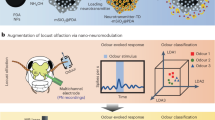Abstract
Bio-hybrid systems provide an opportunity for integrating a living bio-active unit and a proper biosensing system, to employ the unique properties of the bio-active unit. The biological olfactory system can sense and identify thousands of trace odors. The purpose of this study is to combine olfactory epithelium with microelectrode array (MEA) to establish an olfactory epithelium-MEA hybrid system to record the odor-induced electrophysiological activities of the tissue. In our experiments, extracellular potential of olfactory receptor neurons in intact epithelium were measured in the presence of ethyl ether, acetic acid, butanedione, and acetone, respectively. After the odor-induced response signals were analyzed in the time and frequency domain, the temporal characteristics of response signals were extracted. We found that olfactory epithelium-MEA hybrid system can reflect the in vitro odor information of different signal characteristics and firing modes in vitro. The bio-hybrid sensing system can represent a useful instrument to sense and detect the odorant molecules with well recognizing patterns. With the development of sensor technology, bio-hybrid systems will represent emerging and promising platforms for wide applications, ranging from health care to environmental monitoring.








Similar content being viewed by others
References
D.R. Albrecht, V.L. Tsang, R.L. Sah, S.N. Bhatia, Photo-and electropatterning of hydrogel-encapsulated living cell arrays. Lab Chip 5, 111–118 (2005)
M.F. Bear, B.W. Connors, M.A. Paradiso, Neuroscience: Exploring the brain. (Lippincott Williams & Wilkins, 2007)
L.B. Buck, Olfactory receptors and odor coding in mammals. Nutr. Rev. 62, S184–S188 (2004)
L. Buck, R. Axel, A novel multigene family may encode odorant receptors: a molecular basis for odor recognition. Cell 65, 175–187 (1991)
A.W. Daus, P.G. Layer, C. Thielemann, A spheroid-based biosensor for the label-free detection of drug-induced field potential alterations. Sensors Actuators B Chem. 165, 53–58 (2012)
S. Firestein, How the olfactory system makes sense of scents. Nature 413, 211–218 (2001)
M. Frega, V. Pasquale, M. Tedesco, M. Marcoli, A. Contestabile, M. Nanni, L. Bonzano, G. Maura, M. Chiappalone, Cortical cultures coupled to micro-electrode arrays: a novel approach to perform in vitro excitotoxicity testing. Neurotoxicol. Teratol. 34, 116–127 (2011)
R. Glatz, K. Bailey-Hill, Mimicking nature’s noses: from receptor deorphaning to olfactory biosensing. Prog. Neurobiol. 93, 270–296 (2011)
W. Gopel, C. Ziegler, H. Breer, D. Schild, R. Apfelbach, J. Joerges, R. Malaka, Bioelectronic noses: a status report part I. Biosens. Bionelectron. 13, 479–493 (1998)
A. Hierlemann, U. Frey, S. Hafizovic, F. Heer, Growing cells atop microelectronic chips: interfacing electrogenic cells in vitro with CMOS-based microelectrode arrays”. Proc. IEEE 99(2), 252–284 (2011)
C.T. Ho, R.Z. Lin, W.Y. Chang, H.Y. Chang, C.H. Liu, Rapid heterogeneous liver-cell on-chip patterning via the enhanced field-induced dielectrophoresis trap. Lab Chip 6, 724–734 (2006)
I. Ito, S. Watanabe, Y. Kirino, Air movement evokes electro-olfactogram oscillations in the olfactory epithelium and modulates olfactory processing in a slug. J. Neurophysiol. 96, 1939–1948 (2006)
E. Josephson, S. Yilma, V. Vodyanoy, E. Morrison, Structure and function of long-lived olfactory organotypic cultures from postnatal mice. J. Neurosci. Res. 75, 642–653 (2004)
H.J. Ko, T.H. Park, Piezoelectric olfactory biosensor: ligand specificity and dose-dependence of an olfactory receptor expressed in a heterologous cell system. Biosens. Bioelectron. 20, 1327–1332 (2005)
S.H. Lee, S.B. Jun, H.J. Ko, S.J. Kim, T.H. Park, Cell-based olfactory biosensor using microfabricated planar electrode. Biosens. Bionelectron. 24, 2659–2664 (2009)
Q. Liu, H. Cai, Y. Xu, Y. Li, R. Li, P. Wang, Olfactory cell-based biosensor: a first step towards a neurochip of bioelectronic nose. Biosens. Bionelectron. 22, 318–322 (2006)
Q. Liu, W. Ye, L. Xiao, L. Du, N. Hu, P. Wang, Extracellular potentials recording in intact olfactory epithelium by microelectrode array for a bioelectronic nose. Biosens. Bionelectron. 25, 2212–2217 (2010)
P.M. Lledo, G. Gheusi, J.D. Vincent, Information processing in the mammalian olfactory system. Physiol. Rev. 85, 281–317 (2005)
C.A. Lowry, L.M. Kay, Chemical factors determine olfactory system beta oscillations in waking rats. J. Neurophysiol. 98, 394–404 (2007)
M. Marrakchi, J. Vidic, N. Jaffrezic-Renault, C. Martelet, E. Pajot-Augy, A new concept of olfactory biosensor based on interdigitated microelectrodes and immobilized yeasts expressing the human receptor OR17-40. Eur. Biophys. J. 36, 1015–1018 (2007)
U.J. Meierhenrich, J. Golebiowski, X. Fernandez, D. Cabrol-Bass, The molecular basis of olfactory chemoreception. Angew. Chem. Int. Ed. 43, 6410–6412 (2004)
N. Misawa, H. Mitsuno, R. Kanzaki, S. Takeuchi, Highly sensitive and selective odorant sensor using living cells expressing insect olfactory receptors. Proc. Nat. Acad. Sci. 107, 15340–15344 (2010)
P. Nef, I. Hermans-Borgmeyer, H. Artieres-Pin, L. Beasley, V.E. Dionne, S.F. Heinemann, Spatial pattern of receptor expression in the olfactory epithelium. Proc. Nat. Acad. Sci. 89, 8948–8952 (1992)
W.T. Nickell, N.K. Kleene, S.J. Kleene, Mechanisms of neuronal chloride accumulation in intact mouse olfactory epithelium. J. Physiol. 583, 1005–1020 (2007)
J. Niessing, R.W. Friedrich, Olfactory pattern classification by discrete neuronal network states. Nature 465, 47–52 (2010)
T.H. Park, M.L. Shuler, Integration of cell culture and microfabrication technology. Biotechnol. Progr. 19, 243–253 (2003)
F. Rock, N. Barsan, U. Weimar, Electronic nose: current status and future trends. Chem. Rev. 108, 705–725 (2008)
A.S. Rudolph, J. Reasor, Cell and tissue based technologies for environmental detection and medical diagnostics. Biosens. Bioelectron. 16, 429–431 (2001)
P. Wang, Q. Liu, Cell-based biosensors: principles and applications (Artech House Publishers, USA, 2009)
Acknowledgments
This work was supported by the National Natural Science Foundation of China (Grant No. 81027003, 81071226), the Research on Public Welfare Technology Application Projects of Zhejiang Province, China (No. 2011C23096), the Zhejiang Provincial Natural Science Foundation of China (No. Y2100684), and the Fundamental Research Funds for the Central Universities. The authors sincerely thank the anonymous reviewers and editors for their valuable comments that have led to the present improved version of the original manuscript.
Author information
Authors and Affiliations
Corresponding author
Rights and permissions
About this article
Cite this article
Liu, Q., Hu, N., Zhang, F. et al. Olfactory epithelium biosensor: odor discrimination of receptor neurons from a bio-hybrid sensing system. Biomed Microdevices 14, 1055–1061 (2012). https://doi.org/10.1007/s10544-012-9705-0
Published:
Issue Date:
DOI: https://doi.org/10.1007/s10544-012-9705-0




